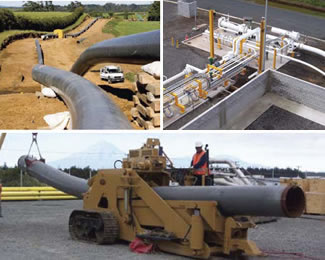Safer transport of oil will protect Santa Barbara coastline

For most environmental organizations, news of an oil pipeline approved in their backyard would be tantamount to war. But not for the Environmental Defense Center (EDC) of Santa Barbara, which celebrated the announcement this week that a pipeline would soon replace barging from Venoco’s oil drilling platforms off the Santa Barbara Coast.
According to a news release from the EDC, Venoco will commence construction of the pipeline this fall and cease its barging operations in the spring.
“We are overjoyed to finally end oil barging off the coast,” exclaimed Abe Powell, President of GOO! (Get Out Oil), one of the organizations represented by the EDC. “The Coastal Commission’s action will result in a tremendous benefit to the California coast.”
Approval by the California Coastal Commission was the final regulatory hurdle in the lengthy effort to replace the dangerous and polluting barging operations with what many consider a safer alternative.
“Oil tankering and barging are the most risky methods of transporting oil. An offshore oil spill would be much larger and more difficult to clean up than a spill from an onshore pipeline,” Linda Krop, Chief Counsel of the EDC told me this week in an email.
Santa Barbara was the site in 1969 of the first major offshore oil spill in the United States, an event that resulted in the modern environmental movement and the creation of Earth Day. Although the Santa Barbara spill has since been eclipsed by others – most notably last year’s Louisiana Gulf Coast conflagration on a BP-run oil platform – it remains one of the hallmark events in offshore oil drilling and has left mental scars on the people of the Santa Barbara coast. This is not a “drill, baby, drill” political stronghold.
But Krop points to high-tech safety features of modern pipelines that protect the environment through automatic leak detection and shut down technology if even a small leak occurs.
“In addition,” Krop told me, “oil barging is a source of air pollution, greenhouse gas emissions and noxious odors. None of these impacts would be associated with the pipeline.”
The approved plan creates roughly eight-and-a-half new miles of onshore pipe, connecting the Ellwood terminal adjacent to Sandpiper Golf Course to the Exxon facility up the coast in Gaviota’s Las Flores Canyon. The crude, once at Las Flores, will then be able to tie into existing pipes and be sent to refineries up and down the coast as well as inland.
I asked Krop whether she thought this new agreement with Venoco to end offshore barging and convert to pipeline transportation would set a new national standard for the industry, and while she noted that there is nothing binding other locales to such action, she added:
“it is consistent with state law and local policies preferring pipeline transportation. As a practical matter, however, hopefully it will encourage other operators to choose the environmentally preferred path of pipelines rather than barges.”
Construction on the new pipeline — which, it should be noted, will by and large be sited on existing roads and easements with special attention given to habitat restoration and spill safety protocols — is scheduled to begin on October 1.




